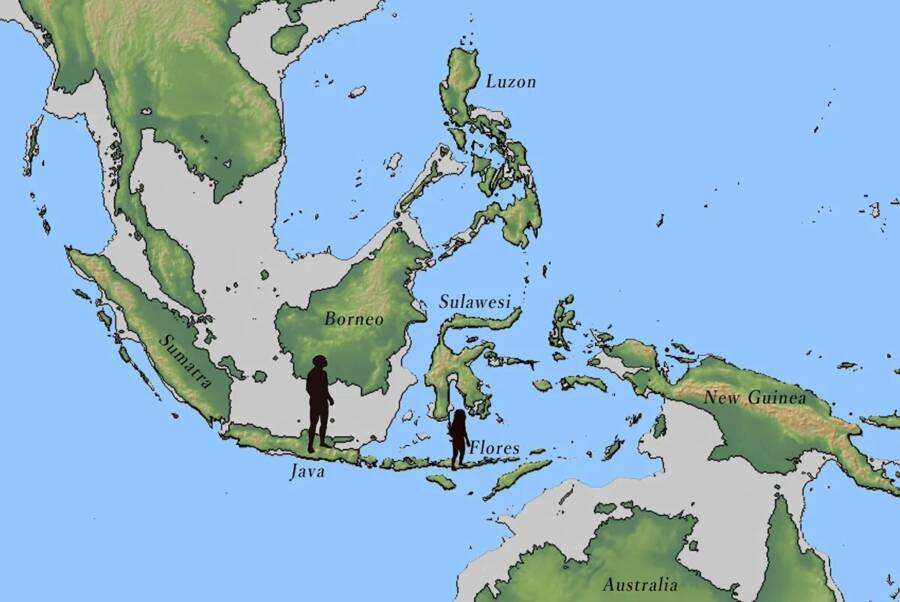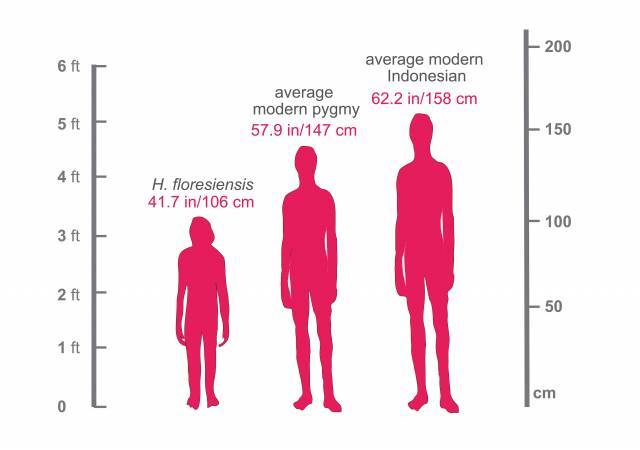Homo floresiensis, nicknamed "Hobbits" after their short stature, once roamed Indonesia thousands of years ago. Now, researchers have identified fossils belonging to an even older and smaller group nearby.

Yousuke KaifuA fragment of an upper arm bone, or humerus, from a possible Homo floresiensis ancestor 700,000 years ago (left), compared with a humerus from Homo floresiensis (right).
As recently as 50,000 years ago, an early hominin species called Homo floresiensis lived on the island of Flores in modern-day Indonesia. At roughly 3’6″ tall, this species was remarkably small, earning it the nickname “Hobbit” when its fossils were first discovered in 2003.
For years, academics have debated the origins of this hominin species, as well as the reason for its small stature. Now, a new study has identified an even older and smaller species that may be an ancestor of Homo floresiensis, shedding light on the evolution of this mysterious hominin.
Archaeologists Unearth “Hobbit” Fossils In Indonesia
Over twenty years ago, researchers unearthed the fossils of an early human species called Homo floresiensis in Liang Bua cave on the island of Flores, Indonesia. Remarkably, the fossils showed that the species stood at roughly 3’6″ tall, earning it the nickname “Hobbit” after the fictional creatures featured in J.R.R. Tolkien’s The Lord of the Rings books.
Homo floresiensis lived in modern-day Indonesia between 50,000 to 100,000 years ago. They had large teeth, no chins, receding foreheads, and disproportionately large feet.
Although their brains were small, Homo floresiensis crafted stone tools which they used to hunt local fauna and may have even utilized fire.
According to the Smithsonian National Museum of Natural History, their short stature may have been the result of isolation on the island, where there were likely no predators and limited food resources.
Since their discovery, researchers have attempted to crack the mystery behind how this early human species got to Indonesia and why they were so small in comparison to other hominins.
Popular theories suggest that Homo floresiensis were early descendants of Homo erectus, the first hominin species known to travel beyond Africa. Others suggest that Homo floresiensis could descend from a species that predates Homo erectus.
Now, a new study has found convincing evidence that Homo Floresiensis evolved from an even smaller early hominin species.
A New Study Reveals The Secrets Of Homo Floresiensis

Yousuke Kaifu / GeoMapAppA map showing the discovery locations of the Javanese Homo erectus and Homo floresiensis.
Beginning in 2010, researchers have discovered several new early hominin fossils in Mata Menge in the So’a Basin, a tropical grassland in Indonesia.
These specimens included a jawbone, teeth, and a tiny humerus bone dating back 700,000 years. Shockingly, the remains belonged to three separate individuals with even smaller features than Homo floresiensis.
“We did not expect that we would find smaller individuals from such an old site,” Yousuke Kaifu, co-author of the study recently published in Nature, told CBS.
The research team used digital microscopy to analyze the fossils and discovered that they likely belonged to individuals who stood 3’3″ tall.
“This 700,000-year-old adult humerus is not just shorter than that of Homo floresiensis, it is the smallest upper arm bone known from the hominin fossil record worldwide,” Adam Brumm, a study co-author and archeologist at Griffith University in Australia, stated in a press release.
“The fragment of the upper arm bone (humerus) measures 3.4 inches in its preserved part. We could confidently estimate its original total length as 8-8.89 inches (or 8.3-8.6 inches) which corresponds to the stature of about 3.28 feet,” Kaifu told All That’s Interesting in an email.
Researchers believe these fossils show that Homo floresiensis evolved from even smaller ancestors.

Princeton UniversityA height comparison between three groups: Homo Floresiensis, the average modern Pygmy, and the average modern Indonesian.
“This very rare specimen confirms our hypothesis that the ancestors of Homo floresiensis were extremely small in body size,” Brumm said. “However, it is now apparent from the tiny proportions of this limb bone that the early progenitors of the ‘Hobbit’ were even smaller than we had previously thought.”
Researchers will need to conduct more research in order to conclusively declare any relation to Homo floresiensis.
“The evolutionary history of the Flores hominins is still largely unknown,” Brumm stated. “However, the new fossils strongly suggest that the ‘Hobbit’ story did indeed begin when a group of the early Asian hominins known as Homo erectus somehow became isolated on this remote Indonesian island, perhaps one million years ago, and underwent a dramatic body size reduction over time.”
After reading about the “Hobbit” fossils found in Indonesia, dive into the story of the Callao Man, the early human ancestor who stood only four feet tall. Then, read about Neanderthals, the hominin species that coexisted alongside Homo sapiens.





